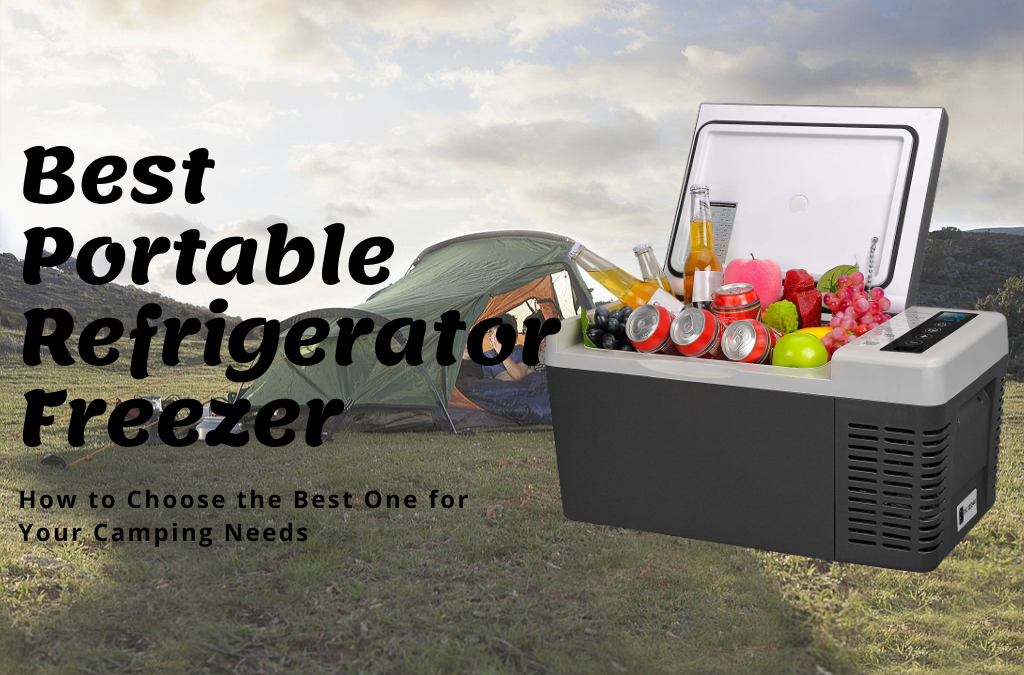Table of Contents
A portable refrigerator freezer can be a large investment if you are one of the campers that frequently go out. It will almost certainly be the most expensive thing in your camping gear. This does not necessarily imply that you need the most expensive refrigerator on the market; it all depends on your specific needs.
Finding a good camping fridge at a reasonable price that does all you want it to can be difficult, but once you know what features to look for, you can go shopping without fear of buying a dud that will cost you much more than you need to pay.
To begin, there are three main types of portable camping refrigerators on the market; knowing which one you’re looking for will help you narrow down your options.
Thermo-Electric
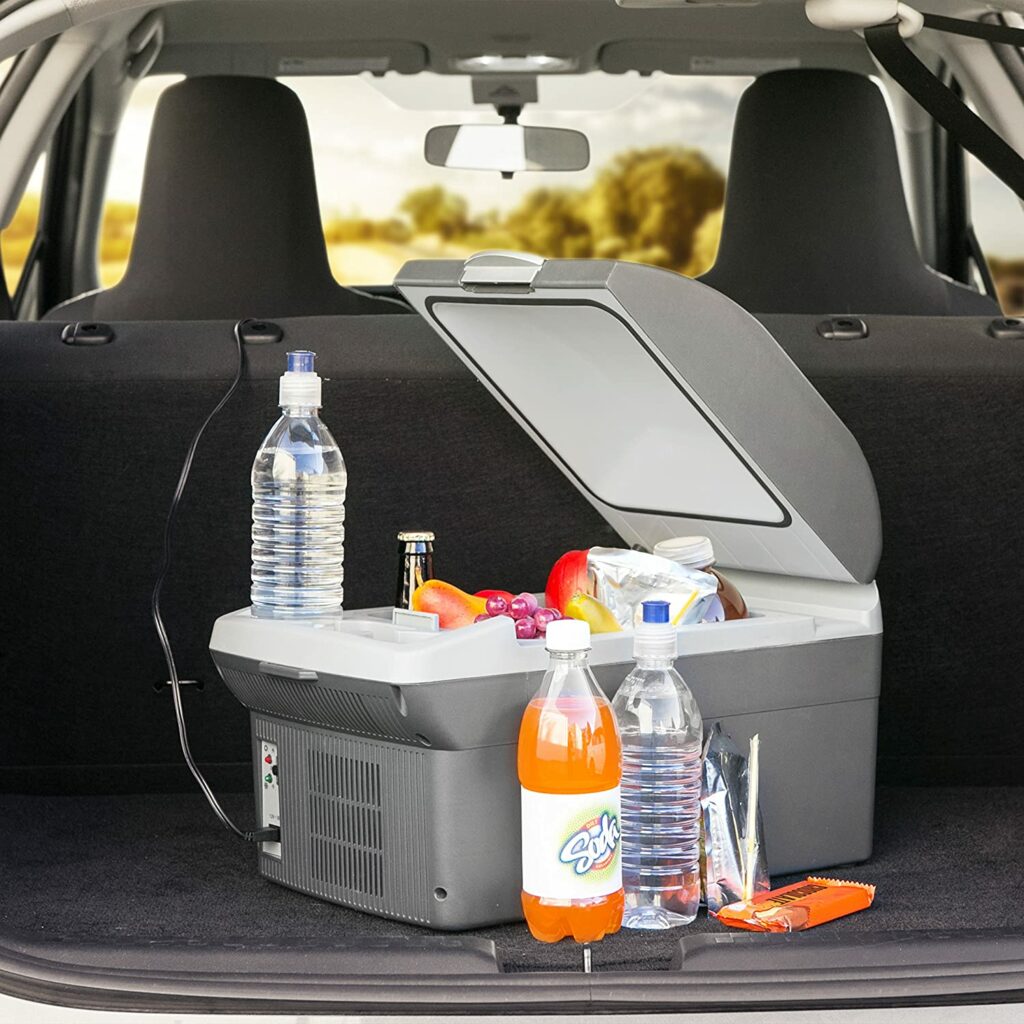
The first is a thermo-electric device, which is the least efficient and uses a thermoelectric ceramic that causes heat inside the cooler to be “sucked out” through a small thermoelectric element, and can typically reduce the temperature by 15-20 degrees below ambient.
While they are less expensive, you can find that by using a small ice box or a cooler bag with ice bricks is more effective at keeping drinks and snacks cold in the real world. Despite the low price, the ‘Peltier’ technology used in these systems has a long way to go before it can compete with the portable refrigerators in the next two categories.
Recommended for You: Best Portable Refrigerator Freezer
3-Way
A 3-way camping fridge is the next style. These are one of the most flexible camping fridge systems available, with the ability to operate on a 9KG LPG gas tank, 12v power, or 240v mains power.
These systems are effective at lowering temperatures by a significant amount; however, since a 3 way camping fridge operates by heating an ammonia solution.
It is very efficient when operating on gas; however, when operating on 12v, the heating element uses about 75Watts of power, resulting in about 6-7amps of power draw, which is around 5-6 times more power than a standard camping fridge.
As a result, a small generator may be needed to keep this device running at a safe temperature for long periods of time, making this a slightly less desirable configuration.
Compressor Style

A compressor style portable refrigerator is the last kind of refrigerator. By compressing a refrigerant and keeping the pressurized gas inside a condenser, and then releasing the compressed gas in a regulated manner, you can rapidly and easily reduce the temperature of the device, similar to how a gas bottle on a BBQ gets cold after a while of use.
Since there is less resistance in a machine that isn’t trying to produce heat, a compressor-style portable refrigerator tends to use a lot less energy. When using the vehicle’s 12v system, the compressor fridge uses an average of 0.85 amps/hour, making it one of the most efficient ways to keep food and drinks cool.
Top Features To Look For In A Portable Refrigerator Freezer
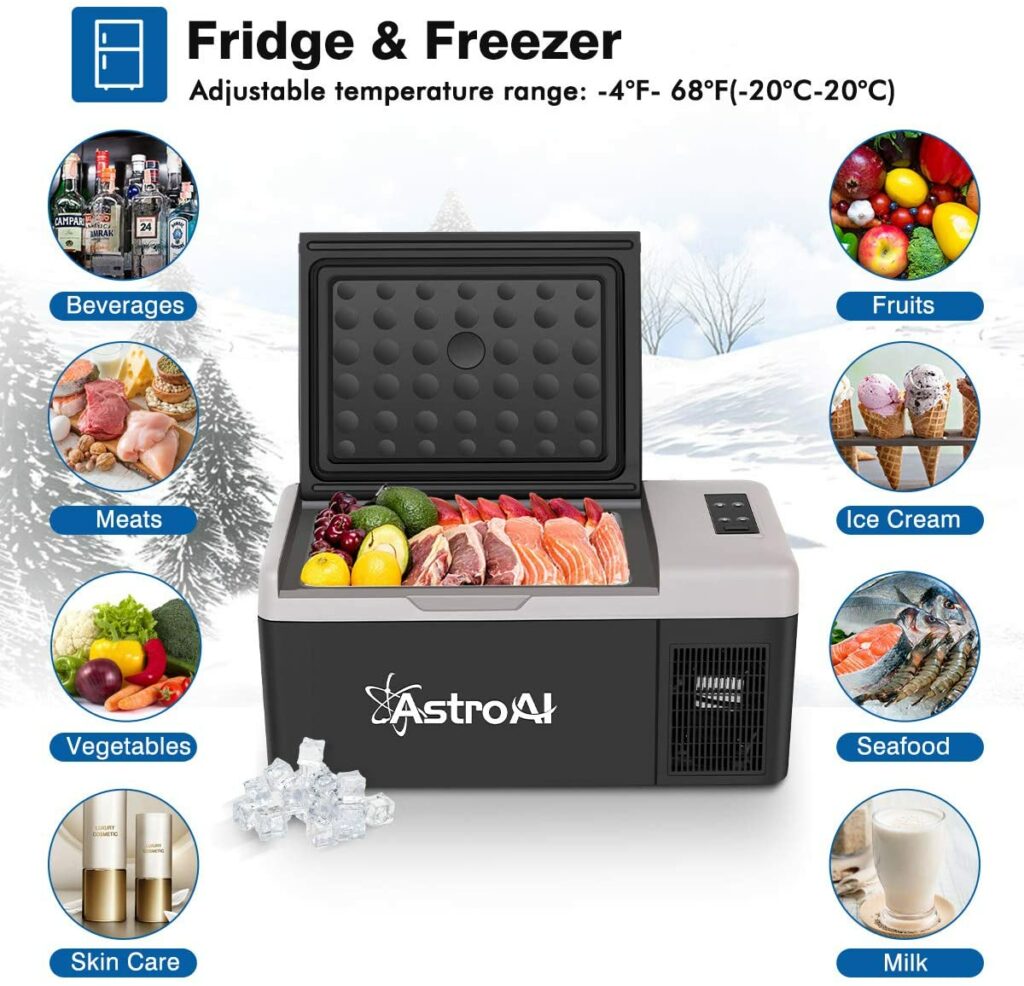
A freezer is one of the most costly and necessary pieces of equipment to purchase when planning your offroad vehicle to travel to remote locations. The variations between the most common models are examined.
Size
Large refrigerators have more power but draw more electricity, and they take up more room in your vehicle. A fully loaded fridge could drive your car over its gross vehicle mass with a whole family and gear already onboard (GVM). Some refrigerators also have expansion inserts that clip onto the top for extra capacity when required.
The sizes are described in liters, but since this can be difficult to visualize, we’ve included a more universal unit of measure: cans of soda.
- Under 25L – 27 cans: These lightweight fridges, which are essentially driven coolers, are ideal for holding lunch cold in a work truck for you and your coworker. They’re also a safe choice if you need to keep drugs refrigerated and close to hand.
- 35L – 47 cans: Perfect for a weekend getaway for two, or a week if you’re traveling alone.
- 40L – 60 cans: The most popular or standard size, 40L fridges are ideal for a long weekend with two or three people.
- 50L – 72 cans: Enough for a week-long trip for two people or a long weekend for the entire family.
- 60–65L – 106 cans: A decent size fridge for a family of five, or provide sustenance for your sporting party. There’s plenty of room to keep the team’s half-time oranges on ice, just keep in mind the amount of space and weight it takes up in your car.
- 80L+ – 120 cans: Enough room for a week away with a large party, but size and weight can be a factor. It may be more cost-effective to split the load between smaller refrigerators and separate vehicles.
Recommended for You: Best Portable Air Conditioners to Keep You Cool Anytime, Anywhere
Two-way or Three-way Portable Fridges?
Two-way refrigerators use electricity, whereas three-way refrigerators use both electricity and gas. So, which is the better option?
Two-way refrigerators use the same compressor technology as a standard refrigerator, but they’re designed to operate on a 12-volt battery as well as mains power.
They’re ideal for most uses because they’re built to run off your car’s electrical system without pulling too much current, but they can also be converted to 240 volts in powered camp sites or at home.
Compressor models, unlike gas fridges, require daily battery charging, so they may not be the best option for a month in the field, but they’ll work fine with a small solar panel system.
Current Drain
Look for a portable refrigerator that uses little power, particularly at 12 volts. This is a clear indicator of how long your battery will last at your campsite or in a parked car, as well as how long your fridge will work.
Five amps is a lot of power, and one amp is a lot of power. Remember that vehicle temperatures will quickly rise, so if you’re parked in the sun with the windows down, your fridge will have to work extra hard.
Opt for a model that cuts over a reasonably high voltage to prevent your battery from hitting the bottom if you’re operating your portable fridge off your starting battery.
Since deep cycling a standard car battery with a portable fridge will shorten its life and leave you stranded, you should consider installing a dual-battery system for regular fridge use. Keep this in mind when calculating the overall cost of your refrigerator.
12-volt Plug-in
Make sure your refrigerator has the right connector for your car. It’s best to use an Anderson style socket, but you might need to get one built. Many portable refrigerators come with a cigarette lighter plug that fits into your vehicle’s accessory socket, but these plugs aren’t designed for high-current draw applications like refrigerators. When you encounter a bump, they can also unplug your fridge, turning it off entirely.
Insulation
Thick walls and insulation will help your compressor run more efficiently. Consider the materials used for the outer casing: metal is more rigid than plastic, so it absorbs heat more readily. Additional insulation is available in the form of thermal covers.
Sturdy Construction
Look for sturdy construction, solid hinges, and tough casings in your refrigerator to ensure it can withstand the rigors you’ll be subjecting it to. A good refrigerator should be capable of withstanding the weight of a person standing on it.
Portable refrigerators come in a range of casing materials, so think about which one is best for you. Metal is durable and ideal for heavy-duty applications, plastic flexes a little and is a good option for touring, and fibreglass is sturdy and corrosion-resistant, making it ideal for marine applications.
Hardware for Mounting
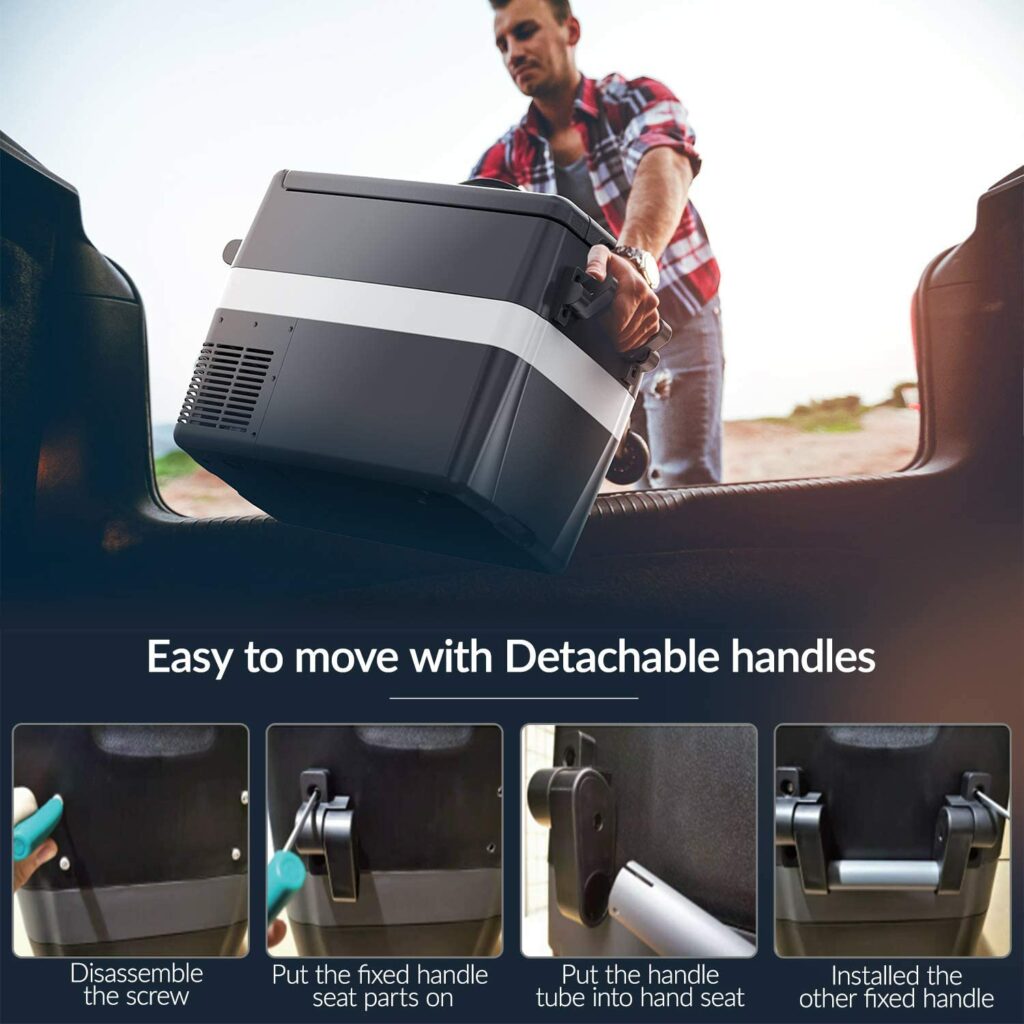
To avoid your fridge tipping over on sharp corners or being a trigger in an accident, you’ll need sturdy mounting hardware. To keep your fridge in place, look for solid mounting points and ensure your vehicle has matching tie-down points.
You may want a specialized mounting kit if you take your outdoor adventures seriously (let’s face it, whether you’re buying a portable fridge, you probably do), and there are a range of OEM and aftermarket mounting kits available for most fridges.
Check that the kits are compatible with both your fridge and your car, and that attaching and removing your fridge is simple when you get home or to camp.
A fridge slide makes it easier to reach refrigerators, and a drop slide makes it even easier – particularly if your 4×4 has been lifted. You may also want to think about shock-absorbing solutions like a foam base.
Fridge Power
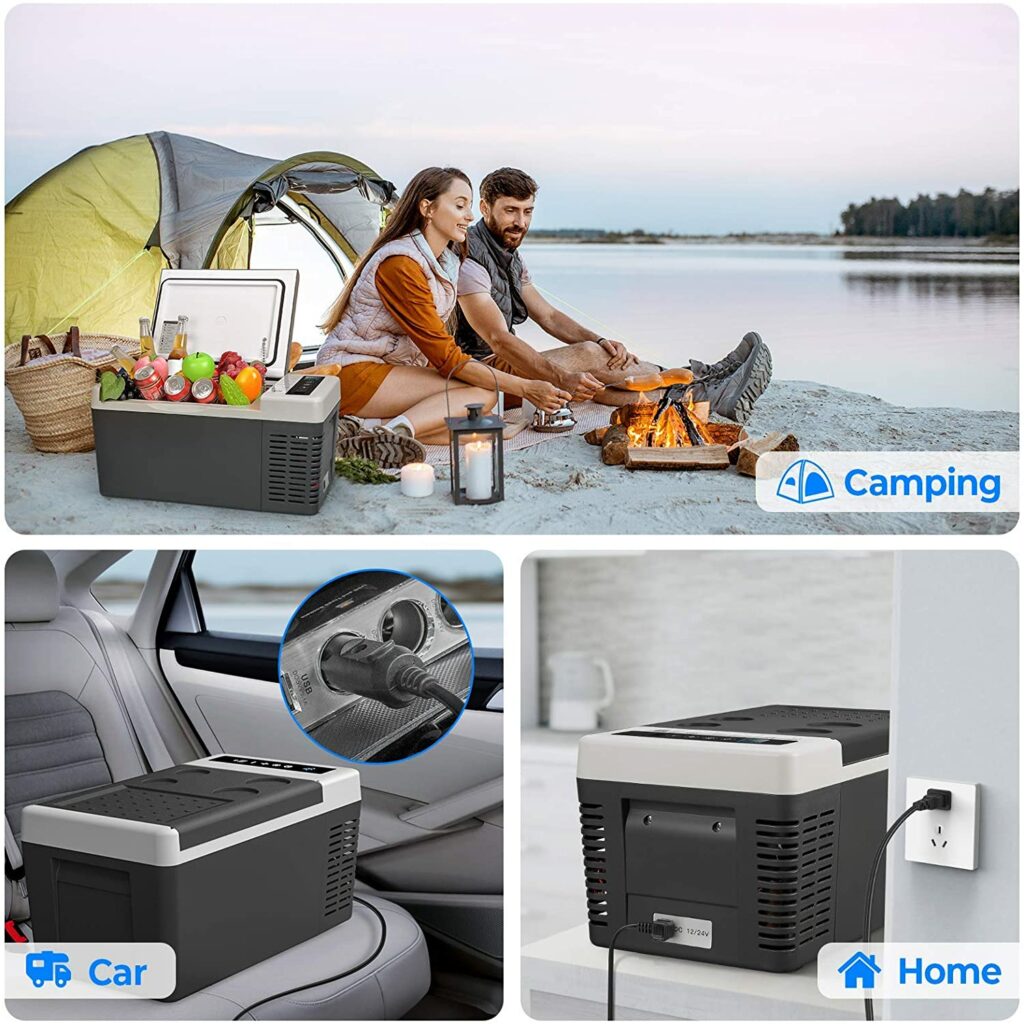
A power supply isn’t needed for passive coolers, but you’ll have to keep refrozen an ice pack. You’ll definitely need a powered fridge if the temperature is high or if you’re going on a longer ride.
Do you want to be able to use your car’s battery to fuel it? Is there a power outlet on the campsite, or would you need to bring your own? Absorption coolers may be powered by gas or, in some cases, solar energy.
Fridge Slide
Whether you’re going to put your fridge in the back of your 4WD, on the ute tray, or in your camping trailer, you’ll need a fridge slide to make it roll in and out.
Bear in mind that refrigerator slides are normally bolted to the floor when preparing the installation. Be sure to account for the size and weight of the fridge slide to ensure that it will match your intended refrigerator.
Keep in mind that they will increase the height of the fridge and the clearance for the lid by a few centimeters.
Final Thoughts
If you’re hiking, boating, fishing, or just going outside for the day, have your favorite refreshments on hand for your next outdoor adventure. This buying guide has all you need to give you an insight into all of the considerations that go into selecting the right portable refrigerator freezer for your needs.

